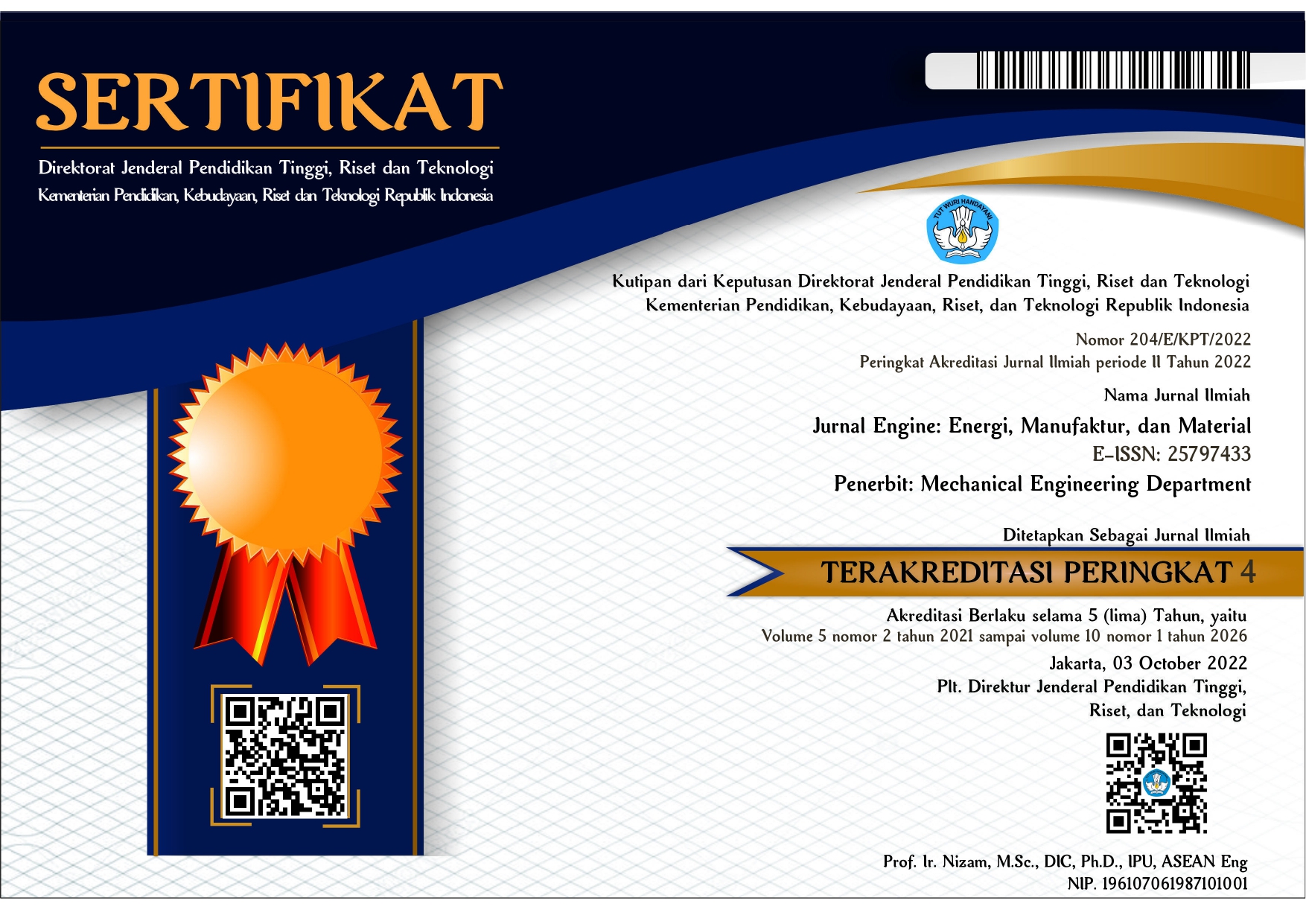Pembuatan Biofuel dengan Proses Pirolisis Berbahan Baku Plastik Low Density Polyethylene (LDPE) pada Suhu 250 °C dan 300 °C
DOI:
https://doi.org/10.30588/jeemm.v1i1.226Keywords:
pyrolisis, biofuel, LDPE plactic, temperature effect, characteristics testAbstract
The level of fuels’ consumption as an energy source in the world is currently experiencing huge increase. When the use of the oil as fuels is not managed properly, it can be sure that the oil will run out and triggered the world’s energy crisis. Currently, plastik waste become a serious problem that can lead into the environment contamination if not properly managed. One of the solution to overcome the energy crisis and environmental polution is to find and create a renewable energy such as biofuel. The research was conducted in order to know the effect of combustion temperature on pyrolisis process based on the Low Density Polythylene (LPDE) plastic material to produce biofuel. The eraly stages of the research was start with pyrolisis process of the LDPE plastic which comes from the bottle and glass logo waste with the reactor temperature of 250 ºC and 300 ºC. The weight of each material was 2 kg. After getting the crude oil, the researcher examined the crude oil characteristic from pyrolisis process using viscosity test, density test, caloric value test, and flash point test. From the test results, the test results that the gigher the temperature in the pyrolisis reactor, the production of the biofuel oil from pyrolisis were more and have a better quality. The result of the experiment pointed out that the higher the pirolysis reactor temperature , the greater the yield and the better quality. The pyrolisis result was crude oil with each of the weight was 240 ml on the 250 ºC reactor temperature and 260 ml on the 300 ºC reactor temperature. The viscosity test showed the results 3.128 mm²/s on the 250 ºC reactor temperature and 2.698 mm²/s on the 300 ºC reactor temperature. The density on the 250 ºC reactor temperature was 0.9984 and 0.9085 on the 300 ºC reactor temperature. The caloric value test on the 250 ºC reactor temperature showed the results 9084.101 kal/g on the first test and 8765.253 kal/g on the second test. Whereas the caloric value test on the 300 ºC reactor temperature were 9588.312 kal/g on the first test and 9507.779 on the second test. The results of the crude oil flash point test on 250 ºC and 300 ºC showed the same temperature result at 28.5 ºC. From the characteristic test results it can be concluded that the crude oil from the pyrolisis process has approaching the kerosene characteristic and entered into the fuel category.References
Arrasyi. (2008). Maltus_PEK (Materi Kuliah), http://arrasyi.wordpress.com/maltuspek-kuliah. Diakses tanggal 24 Mei 2014, 21:55.
Di Blasi. (2008). Modelling Chemical and Physical Processes of Wood and Biomass Pyrolisis. Progress in Energy and Combustion Science, Vol. 34(1), 47-99.
Hardjono, A.( 2001). Teknologi Minyak Bumi. Yogyakarta: Universitas Gadjah Mada.
Hart. (1983). Organic Chemistry: a Short Course. (6th Ed.). Michigan: Houghton Mifflin.
Himawanto, D. A., Indarto, Saptoadi, H. dan Rohmat, T. A. (2010). Pengaruh Heating Rate Pada Proses Slow Pyrolisis Sampah Bambu dan Sampah Daun Pisang. Seminar Rekayasa Kimia dan Proses. ISSN: 1411-4216.
Kurniawan, A. (2012). Mengenal Kode Kemasan Plastik yang Aman dan Tidak. http://ngeblogging.wordpress.com/2012/06/04/mengenal-kemasan-plastik-yang-aman-dan-tidak/. Diakses tanggal 25 Mei 2014, 19:22.
Lailunnazar, L., Wijayanti, W., & Sasongko, M. N. (2003). Pengaruh Temperatur Pirolisis Terhadap Kualitas Tar Hasil Pirolisis Serbuk Kayu Mahoni. Jurnal Teknik Mesin Fakultas Teknik Universitas Brawijaya. Malang: Universitas Brawijaya.
Munson, B. R., Young, D. F. & Okiishi, T. H. (2004). Mekanika Fluida. Jakarta: Penerbit Erlangga.
Nugraha, M. F., Wahyudi, A., & Gunardi, I. (2013). Pembuatan Fuel dari Liquid Hasil Pirolisis Plastik Polipropilen Melalui Proses Reforming Dengan Katalis NiO/y-Al2O3. Jurnal Teknik POMITS (ITS), Vol. 2(2), F299-F302.
Sinaga, P. (2012). Material Plastik. Disampaikan pada Pelatihan Quality Control Alat-alat IPA. Jurusan Pendidikan Fisika UPI dan PT. Sugitex Indotama.
Soedojo, P. (1986). Azas-Azas Ilmu Fisika. Yogyakarta: Gadjah Mada Universitry Press.
Surono, U. B. (2013). Berbagai Metode Konversi Sampah Plastik Menjadi Bahan Bakar Minyak. Artikel Jurusan Teknik Mesin. Yogyakarta: Universitas Janabadra.
Suyanto, W. & Arifin, Z. (2003). Bahan Bakar dan Pelumas. Yogyakarta: Fakultas Teknik, Universitas Negeri Yogyakarta.
UNEP (United Nations Environment Programme). (2009). Converting Waste Plastic Into a Resource. Division of Technology, Industry and Economics.
Wijaya, K. (2012). Biofuel di Indonesia: Prospek, Perspektif dan Strategi Pengembangannya. Yogyakarta: Universitas Gadjah Mada.
Downloads
Published
How to Cite
Issue
Section
License
Authors who publish with Jurnal Engine: Energi, Manufaktur, dan Material agree to the following terms:
Authors retain copyright and grant the Jurnal Engine: Energi, Manufaktur, dan Material right of first publication with the work simultaneously licensed under a Creative Commons Attribution 4.0 International License that allows others to share (copy and redistribute the material in any medium or format) and adapt (remix, transform, and build upon the material) the work for any purpose, even commercially with an acknowledgment of the work's authorship and initial publication in Jurnal Engine: Energi, Manufaktur, dan Material. Authors are able to enter into separate, additional contractual arrangements for the non-exclusive distribution of the journal's published version of the work (e.g., post it to an institutional repository or publish it in a book), with an acknowledgment of its initial publication in Jurnal Engine: Energi, Manufaktur, dan Material. Authors are permitted and encouraged to post their work online (e.g., in institutional repositories or on their website) prior to and during the submission process, as it can lead to productive exchanges, as well as earlier and greater citation of published work (See The Effect of Open Access).


















